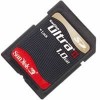SanDisk SDSDH-1024 Product Manual - Page 32
Card Identification Register
 |
UPC - 710348911073
View all SanDisk SDSDH-1024 manuals
Add to My Manuals
Save this manual to your list of manuals |
Page 32 highlights
Revision 2.2 Chapter 3 - SD Card Interface Description SD Card Product Manual 3.5.2 Card Identification Register The Card Identification Register (CID)12 is 16 bytes long and contains a unique card identification number as shown in Table 3-10. It is programmed during card manufacturing and cannot be changed by SD Card hosts. Table 3-10 CID Register Definitions Name Manufacturer ID (MID) Type Binary Width 8 OEM/Application ID (OID) ASCII 16 Product Name (PNM) ASCII 40 Product Revision14 Serial Number (PSN) BCD 8 Binary 32 CID-Slice [127:120] [119:104] [103:64] [63:56] [55:24] CID Value 0x03 SD ASCII Code 0x53, 0x44 SD02G SD01G SD512 SD256 SD128 SD64 SD32 SD16 Product Revision xx Product Serial Number Comments Manufacturer IDs are controlled and assigned by the SD Card Association Identifies the card OEM and/or the card contents. The OID is assigned by the 3C.13 Five ASCII characters long Two binary-coded decimal digits 32-bit unsigned integer Reserved --- 4 Manufacture Date Code BCD 12 (MDT) CRC7 checksum (CRC) Not used, always "1" Binary 7 --- 1 [23:20] [19:8] [7:1] [0.0] --- Manufacture date (for ex. April 2001= 0x014) CRC7* --- --- Manufacturing date-yym (offset from 2000) Calculated --- *The CRC checksum is computed by using the following formula: CRC Calculation: G(x)=x7+3+1 M(x)=(MID-MSB)*x119+...+(CIN-LSB)*x0 CRC[6...0]=Remainder[(M(x)*x7)/G(x)] 12 The CID Register in the SD Card has a different structure than in the MultiMediaCard. 13 3C represents the three SDA founding companies: Toshiba, SanDisk, and MEI. 14 The product revision is composed of two binary-coded decimal (BCD) digits (4 bits ea.) representing and "n.m" revision number. The "n" is the most significant nibble and the "m" is the least significant nibble. Example: the PRV binary value filed for product revision (6.2) would be "01100010". © 2004 SanDisk Corporation 3-12 12/08/04















